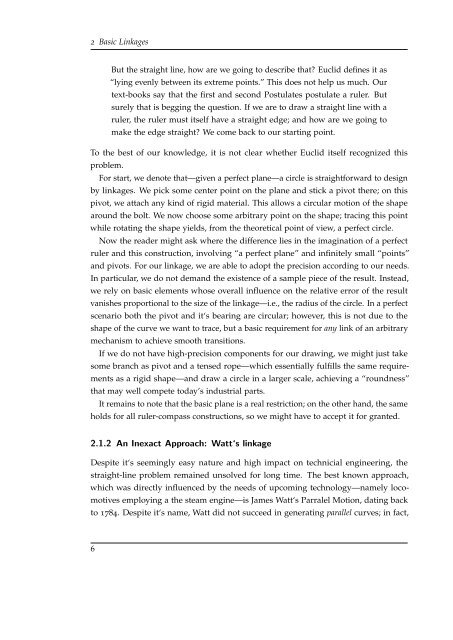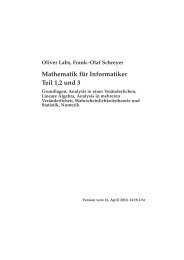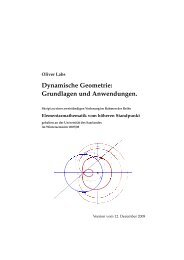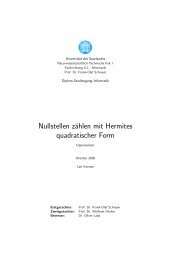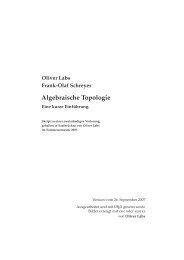Automated Generation of Kempe Linkages for ... - Alexander Kobel
Automated Generation of Kempe Linkages for ... - Alexander Kobel
Automated Generation of Kempe Linkages for ... - Alexander Kobel
You also want an ePaper? Increase the reach of your titles
YUMPU automatically turns print PDFs into web optimized ePapers that Google loves.
2 Basic <strong>Linkages</strong><br />
But the straight line, how are we going to describe that? Euclid defines it as<br />
“lying evenly between its extreme points.” This does not help us much. Our<br />
text-books say that the first and second Postulates postulate a ruler. But<br />
surely that is begging the question. If we are to draw a straight line with a<br />
ruler, the ruler must itself have a straight edge; and how are we going to<br />
make the edge straight? We come back to our starting point.<br />
To the best <strong>of</strong> our knowledge, it is not clear whether Euclid itself recognized this<br />
problem.<br />
For start, we denote that—given a perfect plane—a circle is straight<strong>for</strong>ward to design<br />
by linkages. We pick some center point on the plane and stick a pivot there; on this<br />
pivot, we attach any kind <strong>of</strong> rigid material. This allows a circular motion <strong>of</strong> the shape<br />
around the bolt. We now choose some arbitrary point on the shape; tracing this point<br />
while rotating the shape yields, from the theoretical point <strong>of</strong> view, a perfect circle.<br />
Now the reader might ask where the difference lies in the imagination <strong>of</strong> a perfect<br />
ruler and this construction, involving “a perfect plane” and infinitely small “points”<br />
and pivots. For our linkage, we are able to adopt the precision according to our needs.<br />
In particular, we do not demand the existence <strong>of</strong> a sample piece <strong>of</strong> the result. Instead,<br />
we rely on basic elements whose overall influence on the relative error <strong>of</strong> the result<br />
vanishes proportional to the size <strong>of</strong> the linkage—i.e., the radius <strong>of</strong> the circle. In a perfect<br />
scenario both the pivot and it‘s bearing are circular; however, this is not due to the<br />
shape <strong>of</strong> the curve we want to trace, but a basic requirement <strong>for</strong> any link <strong>of</strong> an arbitrary<br />
mechanism to achieve smooth transitions.<br />
If we do not have high-precision components <strong>for</strong> our drawing, we might just take<br />
some branch as pivot and a tensed rope—which essentially fulfills the same requirements<br />
as a rigid shape—and draw a circle in a larger scale, achieving a “roundness”<br />
that may well compete today’s industrial parts.<br />
It remains to note that the basic plane is a real restriction; on the other hand, the same<br />
holds <strong>for</strong> all ruler-compass constructions, so we might have to accept it <strong>for</strong> granted.<br />
2.1.2 An Inexact Approach: Watt‘s linkage<br />
Despite it‘s seemingly easy nature and high impact on technicial engineering, the<br />
straight-line problem remained unsolved <strong>for</strong> long time. The best known approach,<br />
which was directly influenced by the needs <strong>of</strong> upcoming technology—namely locomotives<br />
employing a the steam engine—is James Watt‘s Parralel Motion, dating back<br />
to 1784. Despite it‘s name, Watt did not succeed in generating parallel curves; in fact,<br />
6


